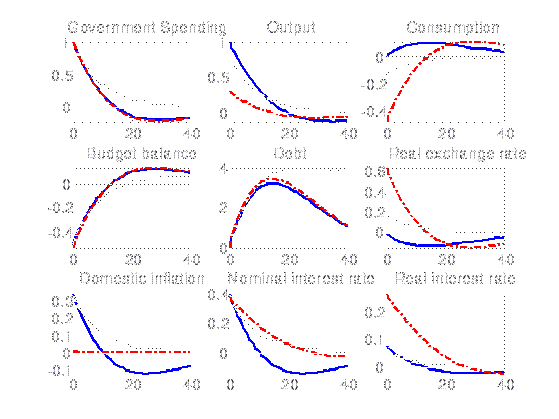SparkNotes Policy Debates Problems with Monetary Policy and Fiscal policy
Post on: 26 Май, 2015 No Comment

Problems
Monetary policy and fiscal policy under a system of fixed output
Initially, monetary policy and fiscal policy were introduced in an economy where changes in these policies would affect output. In reality, there is no real link between monetary policy and real variables. That is, changes in monetary policy and fiscal policy cannot affect the total level of output because the total level of output is determined by the factors of production and not by monetary variables. This is called the neutrality of money.
What really happens, then, when the Fed and the government use monetary policy and fiscal policy? If we recall the equation for output of Y = C(Y — T) + I + G + NX we can begin this analysis. Given that Y is fixed by the factors of production, a change in G or T—that is, fiscal policy—must result in a change in another variable to maintain a constant Y. This change in Y works directly though the interest rate.
Each of the variables in the output equation is tied to the interest rate. Consumption tends to fall as the interest rate rises because the incentive for saving increases. Investment tends to fall as the interest rate rises because the cost of borrowing money increases. Government spending is not really affected by the interest rate. Net exports tend to rise as interest rates rise because domestic investment is relatively more attractive to both domestic and foreign investors.
When monetary policy and fiscal policy are used the interest rate is affected. Expansionary monetary policy directly lowers the interest rate by making money easier and cheaper to obtain. Contractionary monetary policy directly raises the interest rate by making money harder and more expensive to obtain. Expansionary fiscal policy increases the interest rate by decreasing the savings rate through lower taxes and higher government spending. Contractionary fiscal policy decreases the interest rate by increasing the savings rate through higher taxes and lower government spending. Thus, monetary policy and fiscal policy both directly affect consumption, investment, and net exports through the interest rate.
For example, say the Fed uses expansionary monetary policy such as purchasing government bonds, decreasing the reserve requirement, or decreasing the federal funds interest rate. This causes the interest rate to fall, which then causes consumption to rise and investment to rise. But, in order for the total level of output to remain fixed, net exports must fall the same amount that consumption and investment rise. In this way, total output does not change from monetary policy, but the division of total output is affected.
Another example is needed. Say the Fed uses contractionary monetary policy such as selling government bonds, increasing the reserve requirement, or increasing the federal funds rate. This causes the interest rate to rise which causes consumption to fall and investment to fall. But, in order for the total level of output to remain fixed, net exports must rise by the same amount that consumption and investment fall. In this way, total output does not change from monetary policy, but the division of total output is affected.
Fiscal policy and crowding out
Fiscal policy has a very important affect on the division of total output. This is one major negative effect of fiscal policy. Recall that the tools of fiscal policy are taxes and government spending. When the government increases government spending, there should be an indirect increase in output, as mitigated by the government spending multiplier.
In reality, government spending does not change output as the government spending multiplier would seem to indicate. It does, instead, significatly change the interest rate. A rise in the interest rate has a strong affect on investment. That is, as the interest rate rises, investment falls. This is because the interest rate is the opportunity cost of holding money, and as this increases, taking out loans becomes relatively less attractive.
When the government increases spending, the interest rate rises and investment falls. This is called crowding out. That is, increases in government spending tend to replace, or crowd out, private investment. This works because the total level of output is fixed by the factors of production, thus causing there necessarily to be an equal and opposite change from an increase in government purchases. Because investment is more sensitive to interest rates than either consumption or net exports, investment takes the primary hit from the fiscal policy change. For this reason, crowding out always occurs when expansionary fiscal policy is used. In the long run, this crowding out may hamper economic growth since investment affects the factors of production, which do affect total output.
When taxes decrease, consumption immediately rises because disposable income rises. But, since total output is fixed by the factors of production and government spending is fixed by fiscal policy, a change in consumption is met by and equal and opposite change in investment. Here again the case exists where a change in fiscal policy crowds out investment. In this way, a tradeoff is created between the short run and long run effects of fiscal policy upon the economy due to government spending and taxes replacing, or crowding out, private investment.














